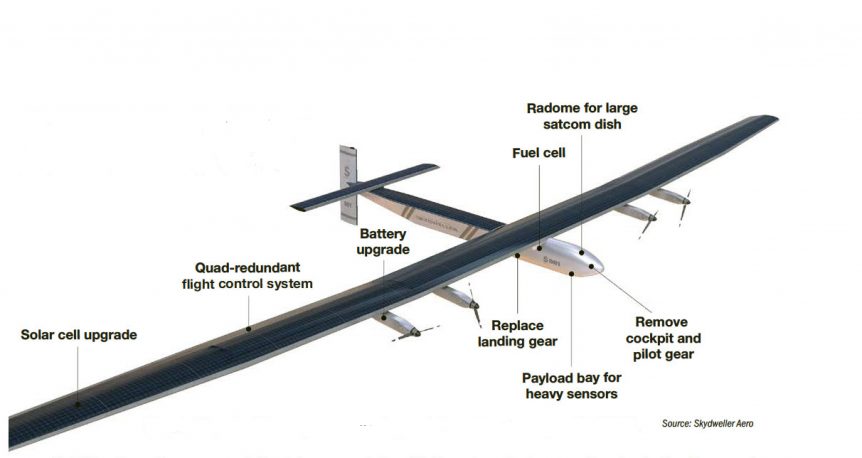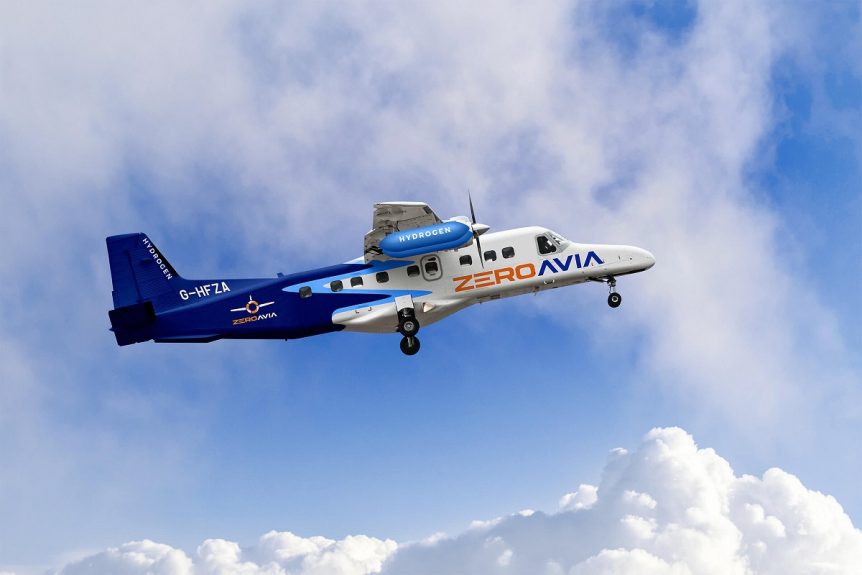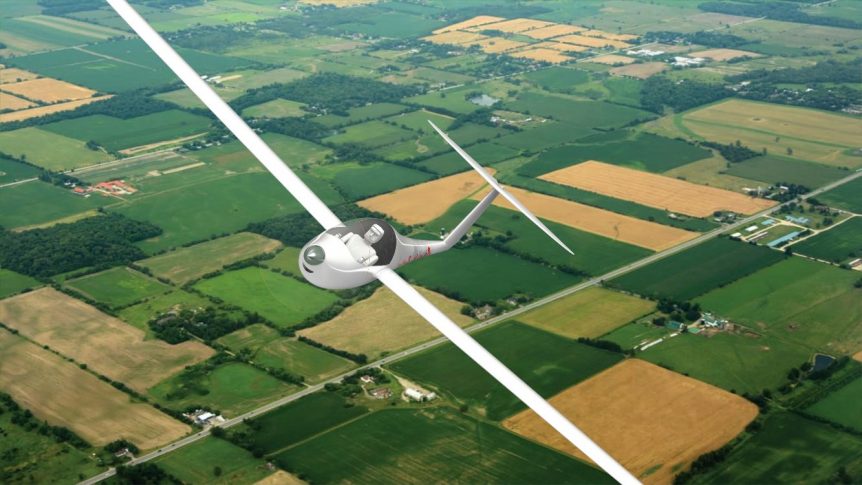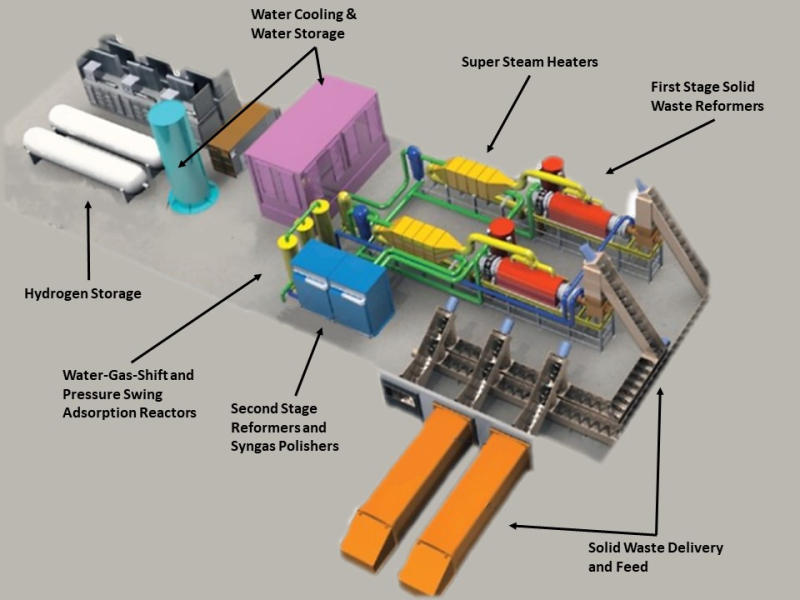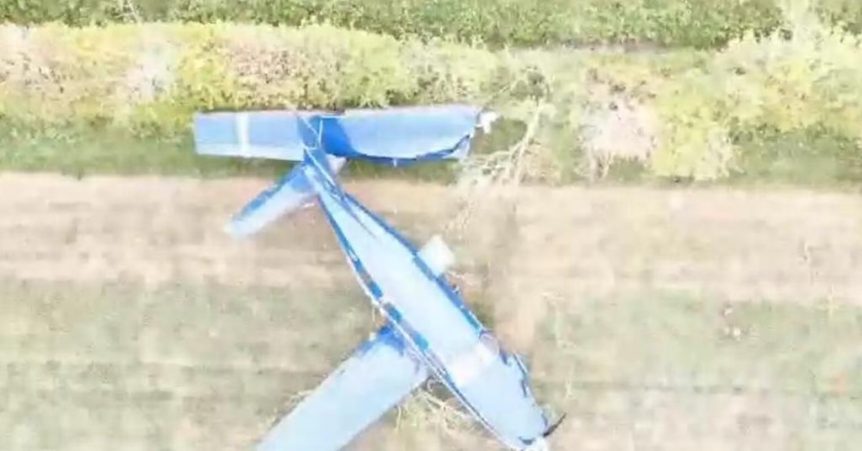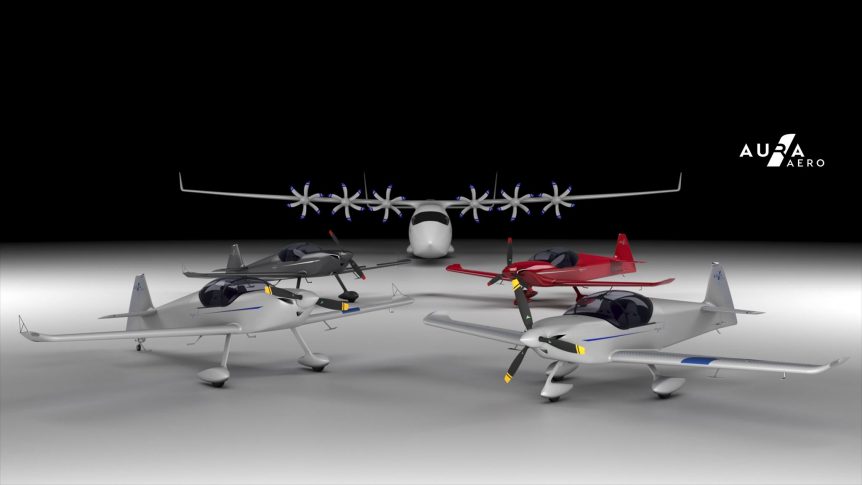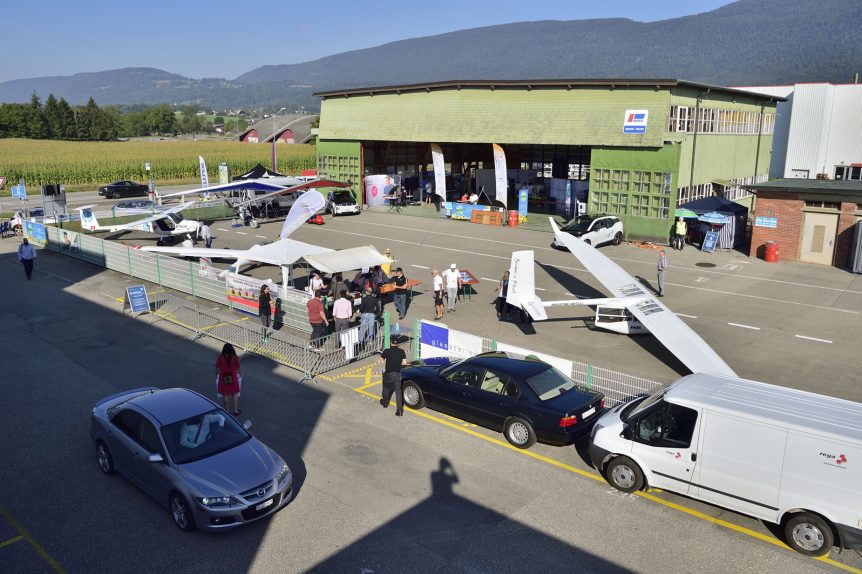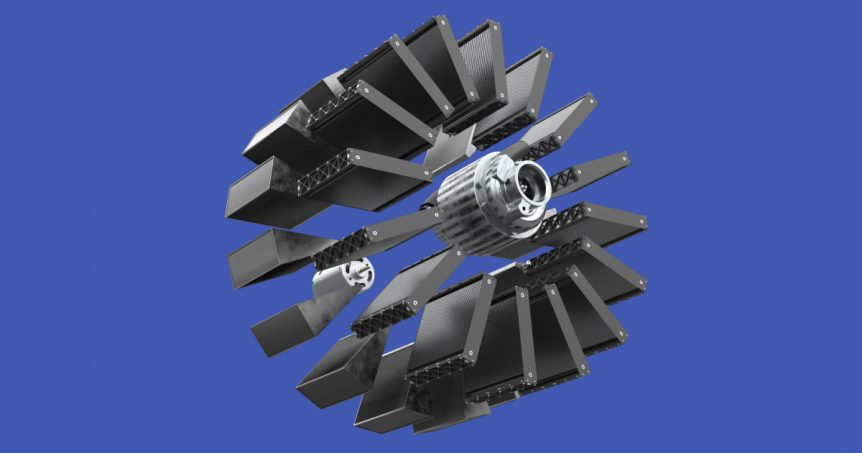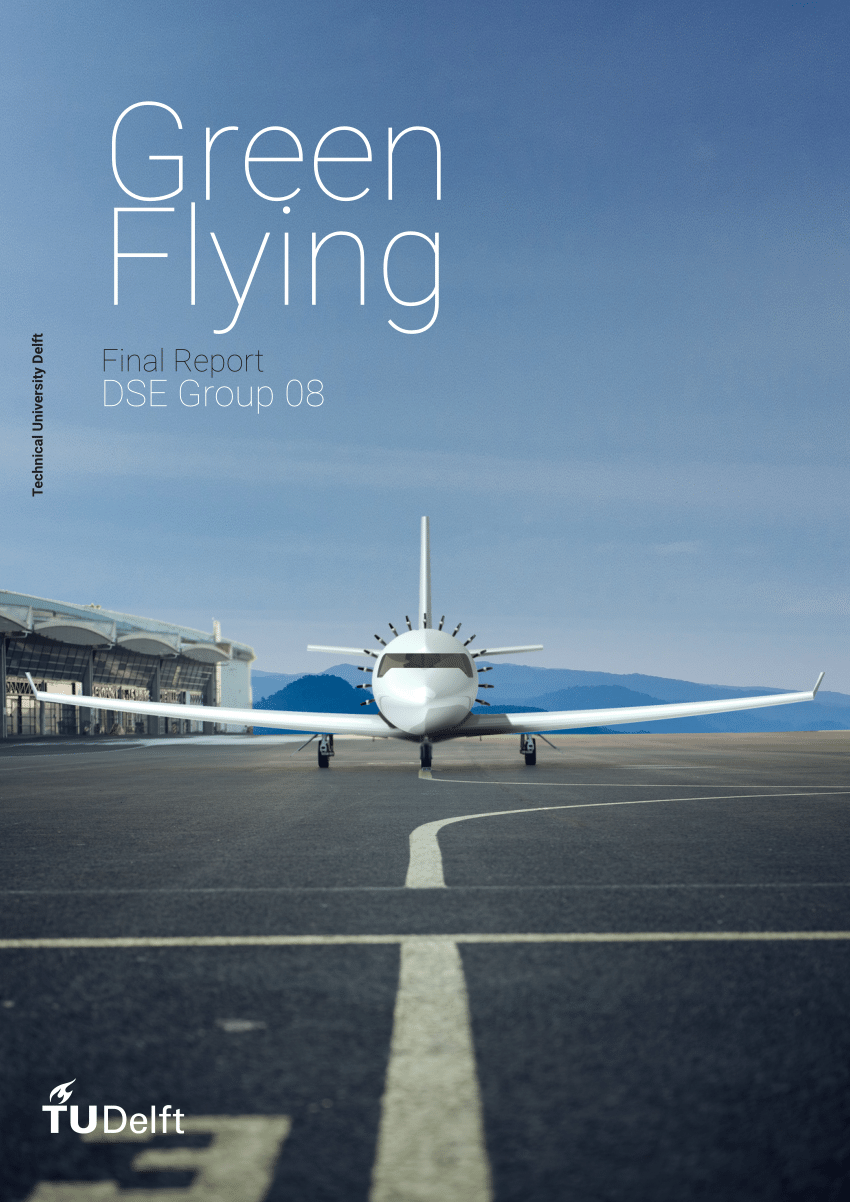Skydweller Aero, an adaptation of Solar Impulse technologies, is working with the U. S. Navy to provide ultra-persistent flight capabilities. It’s using Solar Impulse Two, for which Skydweller purchased the assets and intellectual property rights. Being flown in Spain at this time, the aircraft’s 2,900 square feet of solar cells provide two kilowatts of power, and may be augmented by hydrogen fuel cells in future. In Spain Skydweller founders John Parkes and Robert Miller have headquarters in Oklahoma City, Oklahoma, but are performing flight tests in Spain, coordinating efforts with the University of Castilla-La Mancha (UCLM). After successfully completing ground tests that checked the structure and control systems, Skydweller works toward crafting the software that will guide it on unpiloted missions, scheduled to last at least 30 to 60 days. Such persistence, long sought by the military for ISR (Intelligence, Surveillance and Reconnaissance) missions, is also essential for many future civilian applications. Co-founder John Parkes explained this to Aviation Today. …
Going Big and Bigger with Hydrogen
Two companies promoting hydrogen power for aircraft are upsizing their aspirations, with aircraft hauling four to up to 40 passengers. Both have ambitious timelines. ZeroAvia, operating in Hollister, California and Cirencester, England has been flying a Piper Malibu demonstrator, but anticipates flying a 10 to 20 passenger Dornier by 2024. It would expand that to a 50-passenger craft by 2026. H2Fly in Germany has been flying their Pipistrel-designed HY4 for several years and through six generations. The firm looks forward to taking incremental steps toward a 40-passenger regional airliner by 2030. ZeroAvia ZeroAvia reports on troubling trends in aviation’s contribution to greenhouse gases, but follows with a possible solution. According to their web site, aviation accounts for over 12 percent of total transportation emissions, and may double that by 2050. High altitude contrails mean aviation emissions have two to four times the effect of ground source emissions. Regulators want drastic changes. The European Union mandates a one quarter the CO2 …
Spark Solo Gets ZeroAvia Sponsorship
Mike Friend, retired Technology Director for Boeing Aircraft, and Gabriel DeVault, head of drivetrain development for ZeroAvia, are putting a Zero motorcycle motor into Mike’s Spark Solo. There are perhaps dozens of Zero motors flying today, and the 42-pound unit has evolved to powering even two-seat motorgliders like Gabriel’s Sonex Xenos. An Ambitious Project Mike came up with the Spark Solo design as a way to, “Encompass the design process” as well as the “piloting and fabricating” aspects of a project. He wanted to, “Define an airplane uniquely designed around electric propulsion,” noting that, “Past efforts have almost always been adaptations of internal-combustion powered airplanes.” To help forward his design, Mike has been working with his local EAA chapter, for which he is past president. Experimental Aircraft Association (EAA) chapter 406, “Is creating BACE (Bremerton Aviation Center for Education), a place where people can come to learn hands-on skills in airplane design, construction, and maintenance. Our shop area and flight …
RavenSR: Hydrogen from Waste
Green hydrogen is getting a lot of press lately, at least partly because of the possibilities it allows in transportation design. Raven SR, headquartered in Pinedale, Wyoming, has as its mission, “Providing revolutionary, clean technology to convert waste into renewable fuels and energy.” Clean Technica took notice of the company’s interesting location, deep in “an epicenter of the US coal,” the Powder River coal basin. Their article notes some of the politics involved. “The United Mine Workers of America, for one, came through with a statement in support of President Biden’s climate-friendly American Jobs Plan, contingent on its members getting a share of those new green jobs. “In the same statement, UMWA also lobbied for saving the remaining few remaining coal jobs, partly through policies that ramp up demand for the metallurgical coal used in steel making and other industries.” Note that Wyoming’s coal is not metallurgical, though, and would never be used for smelting steel. Diminishing Landfills? America hauls …
ZeroAvia’s Malibu in Off-Airport Incident
We share this press release from ZeroAvia to allay any rumors or misinterpretations as to what happened May 1 on a test flight of ZeroAvia’s Piper Malibu. The aircraft was damaged in an off-airport landing, but everyone on board managed to exit the craft safely and carried out safety protocols. The incident will doubtless be thoroughly investigated by ZeroAvia’s team and by the United Kingdom’s own Civil Aviation Authority. ZeroAvia Off-Airport Landing Review 1 May, 2021, 08:00 BST On April 29th, 2021, ZeroAvia’s R&D aircraft made an off-airport landing just outside Cranfield airport perimeter during a routine pattern test flight (logged as ZeroAvia Test 86, and the 6th flight in this flight testing segment). The aircraft landed normally on its wheels in a flat grass field and almost came to a stop, but was damaged as it caught the left main gear and wing in the uneven terrain at the end of the field at low speed. Everybody involved is …
Two Wood Aircraft Leading to the Future
Two French manufacturers are reverting to bois et toile (wood and fabric) for ultra-modern aircraft. Both of their aircraft will be electrically powered, and both will use non-traditional approaches to construction. In the meantime, both have fairly traditional demonstration models. The French have done wonders with wooden aircraft from the very beginning of aviation. Santos Dumont built the petite Demoiselle with bamboo longerons, for instance, and Henri Mignet crafted his diminutive Pou du Ciel (flea of the sky, or flying flea) from available wood. After World War Two, Messrs Joly and Delemontez fashioned a small single-seater, the Jodel D-9, from wood and ply and powered it with converted VW Kubelwagen engines, Jeep-like German vehicles which littered scrap yards and former battlefields. Avions Mauboussin and Aura Aero use more modern power systems and vastly different approaches to bois and toile structures. Mauboussin Mauboussin goes back to prewar times with small aircraft that look as though they could have come from a …
Electrifly-in: Grenchen 2021
Electrifly-in, formerly the Smartflyer Challenge, is on for September 11 and 12, 2021, in Grenchen, Switzerland. The event, even held in 2020 despite the pandemic, is a compact showing of the latest in electrical aircraft and technology. Watch as this 2019 video as a Φnix (the Greek letter phi + nix –a clever bilingual pun) takes off, circuits the area and makes a landing – all the time flying with other electric aircraft. In this flight, you can see the compact airport (including a grass landing strip) and a lovely setting for a great event. Started as the Smartflyer Challenge* in 2016, the gathering has changed its name to be more inclusive. Last year, even with travel limitations imposed worldwide, saw a healthy turnout of all-electric flyers, ranging from ultralight electric “trikes” to cross-country tourers. From 12 to 50 Kilowatts and Beyond Powering a large number of machines on last year’s flight line, Eck-Geiger Engineering makes a range of motors …
Hypoint’s Radical Radial Fuel Cell Solution
Hypoint proclaims, “We make zero emission air transport possible.” They do this by, “Building a next generation hydrogen fuel cell system that can deliver “Both high specific power: “2,000 Watts/kilogram and high energy density “1,500 Watt-hours/kilogram Exactly what aircraft designers are looking for.” These numbers exceed what the best batteries can manage at this time, and according to the company’s white paper, even better performance is on the way. Batteries vs. Fuel Cells Hypoint proclaims, “The age of zero-emission aviation is currently being prevented by the industry’s reliance on Li-ion batteries, which have a fundamental barrier at the chemistry level.” The firm limits cell performance to 200 Whr/kg, although Bye Aerospace claims 260 Whr/kg for their full battery packs, battery management systems and all. Elon Musk disagrees. CNBC reports, “Tesla co-founder and CEO Elon Musk has dismissed hydrogen fuel cells as ‘mind-bogglingly stupid,’ and that is not the only negative thing he has had to say about the technology. He …
Two Hydrogen-Powered Aerial Vehicles
Two very different hydrogen-powered aerial vehicles have come to our attention, each with a different mission, but both with endurance and range as primary functions. Both use a fairly straightforward fuel cell/motor arrangement to power their flights. Vicor/DMI Fuel Cell Drones Doosan Mobility Innovation (DMI) is a major drone manufacturer, and their largest products push against the FAA’s 55-pound (24.97-kilogram) weight limit. Their DM30, powered with a DS30 fuel cell and a 10.8 liter H2 tank weighs 21 kilograms and can carry a five kilogram (11 pound) payload. Carrying a full payload may require using the smaller seven-liter tank. Alessandro Mascellino, writing in EE Power, describes recent combination of resources that makes long-range drone deliveries possible. “The first machines built as part of the collaboration can fly two hours on a single charge and have already transported masks and emergency supplies between US Virgin Islands. The drones feature a number of power components by Vicor.” Partnering with Vicor, Doosan provides …
Two Ways to Haul 19 on H2
Pipistel and Delft Technical University have introduced hydrogen (H2) powered, 19-seat airliners for the intermediate-range market. Both are unique configurations with unique propulsion concepts. Both attempt to lower drag through the use of their propulsive systems. Pipistrel Miniliner Pipistrel announced their Miniliner concept as a response to a “significant market potential” for a “zero-emission airplane in the 20-seat size class, capable of operating quietly from runways shorter than 1 [kilometer], including grass airstrips at small aerodromes.” Seen as a disruptive element in providing service to currently unserved areas within a 200 to 1,000 kilometer (124 to 620 mile) range, the Miniliner could also serve as a microfeeder craft between small airports and large hubs. Although Pipistrel is somewhat mum about the internal and powerplant details for the craft, the propeller locations seem to indicate a major effort to reduce drag and eliminate wingtip vortices. The tail, for instance, is very much what Bruce Carmichael, a proponent of laminar-flow designs, proposed …

